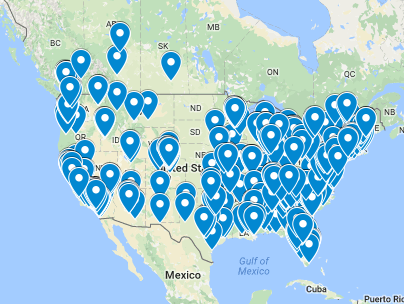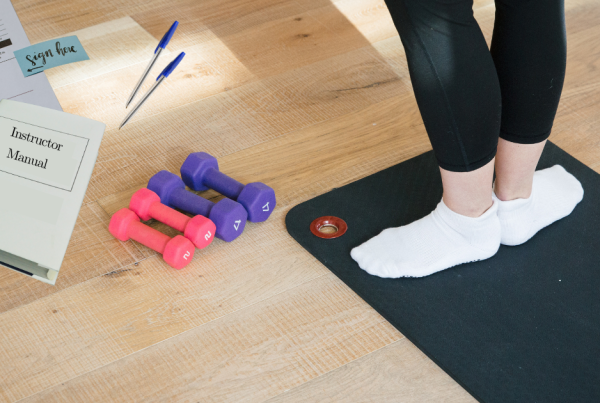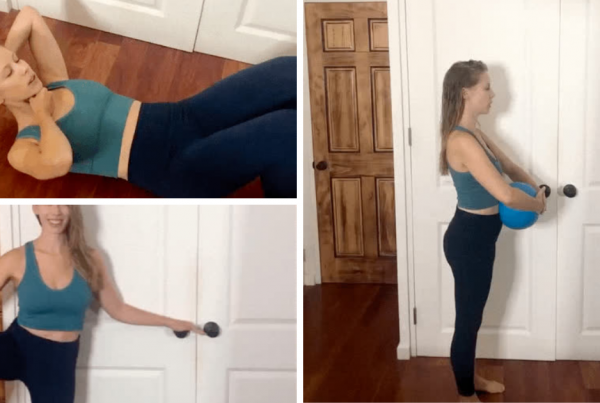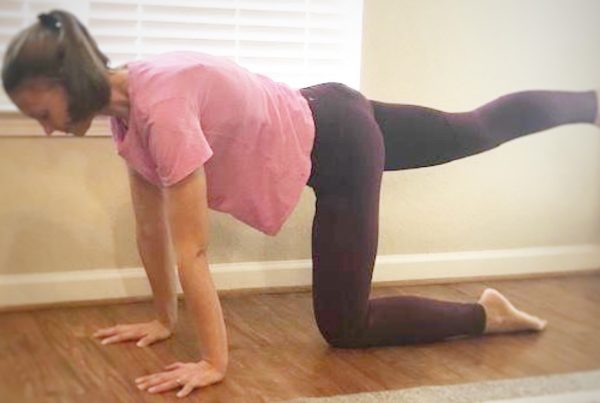Aqua barre, or whatever you want to call a barre class that involves water is a fun way to get a resistance-based workout in while avoiding stress on the joints.
Many barre exercises that you would traditionally see in a studio setting can be adapted for the pool. No equipment is necessary but a pool noodle can help with stability or offer buoyancy while in the water.
As you work through these low-impact movements, you’ll notice that these exercises can help improve your coordination and build up your overall strength and stability with the natural resistance that the water would bring.
How does barre in the water compare to barre on land? I spoke to some aqua barre experts for their insight on the differences between land and water barre!

Photo credit: Wet Barre™
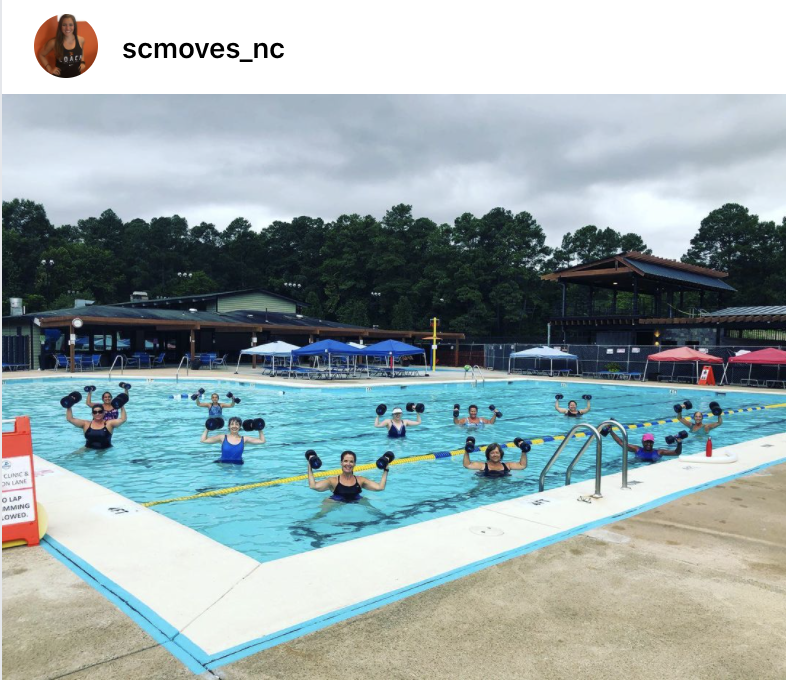
Photo credit: instagram.com/scmoves_nc
Do you need props for aqua barre?
While not necessary, “the most common pieces of equipment used in aquatic barre classes are noodles, and the edge of the pool,” says Wet Barre™ creator Katina Brock. While she advises other pieces of equipment may be used such as bands or kickboards, in general, they are not as essential as a noodle or pool edge.
Aqua Barre Instructor, Sarah Catherine Carter says she also makes use of resistance tubing, aqua dumbbells and mini bands, in addition to pool noodles. “A couple of members have also added waterproof ankle weights to increase the intensity of the workout.”

Photo credit: Wet Barre™
What part of the pool do you use for aqua barre classes?
Typically you use shallow water, that ranges from 3-5 feet in depth, since this area of the pool offers more options and many exercises are designed with the pool floor in mind. “Our members are typically in 4-5 feet of water, which is the depth of our lap pool where most aqua barre classes are held,” says Sarah Catherine.
While there are more options for Katina when utilizing the shallow end of the pool, she says that some exercises that use a pool noodle as a flotation can be done in either the shallow or deeper water, especially if there isn’t enough space for everyone in the shallow end.

Photo credit: Wet Barre™
What about using the wall versus the center of the pool? You can use both! While mostly sticking to the wall, Sarah Catherine directs clients to the center of the pool when there are larger groups, less wall space, and people need to spread out.
I have class plans that make use of the wall as well as class plans that are strictly for the center of the pool. With smaller groups, I enjoy the added challenge of using the wall for abs (for example hands flat, facing the wall, walking the feet up the wall and back down) or for other challenges such as tricep dips. – Sarah Catherine Carter.
According to Katina, while using a wall in the water can help to mimic the feel of a barre class on land that would primarily utilize the barre and floor, a mix of both wall and center of pool exercises offers the best of both worlds. In fact, she says that while the wall offers some great ideas, more options are available away from the wall. As for when to use the wall, she says, “It depends if it benefits the efficacy of the movement or if it benefits the participant as a modification or progression.”
How do you compare barre in the water to barre on land?
There are many similarities between barre in the water versus in a studio setting on land. Many exercises can be adapted for the pool, even if they may look slightly different. According to Sarah Catherine, most leg and seat exercises work well without much modification, and “instead of lying down on the mat, we use noodles and floating to complete core work or standing abs,” she says.
You’re also focusing on the same muscle groups as well as posture, alignment and breathwork, Katina points out.
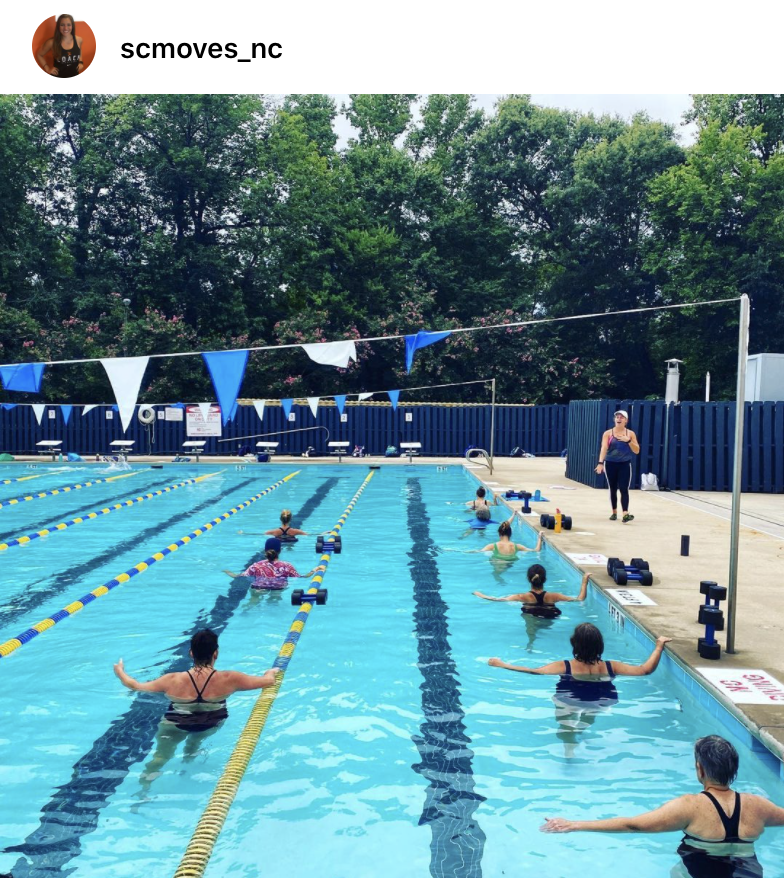
Photo credit: instagram.com/scmoves_nc
Sarah Catherine says that she incorporates a bit more cardio in her aqua barre classes because the water makes the exercises even more low impact. “I can incorporate jumping movements for members of all ages and abilities with an extremely low risk of impacting the joints or injury,” she says. “This adds some heart-healthy aerobic exercise to our routines in addition to building on muscular endurance and the strengthening of the stabilizer muscles that we typically see in a traditional barre class.”
What are the added benefits that you can get from exercise in the water that you can’t get from a studio barre class?
Katina points to a couple specific benefits. First of all, she says that water offers resistance in every direction, and not just against gravity. “Instead of one muscle getting really overworked and trying to offer the opposing muscle a similar training intensity, you can more effectively work both muscles and have any direction as a training option.”
Think of a bicep curl, she says, which contracts the bicep muscles when bending the elbow. “In the water, it will also work the triceps when straightening the elbow with similar force.”
“This is not the case on land as it primarily only loads the biceps in either direction up or down. The lowering phase or eccentric contraction of a biceps curl on land can actually cause more soreness than the concentric or lifting phase. So in water, there’s less soreness which is wonderful and also better for those with inflammatory or fatigue issues!” – Katina Brock
Not to mention that “there’s also potential to burn up to 28% more calories in the water than on land because of this added resistance.” says Sarah Catherine.
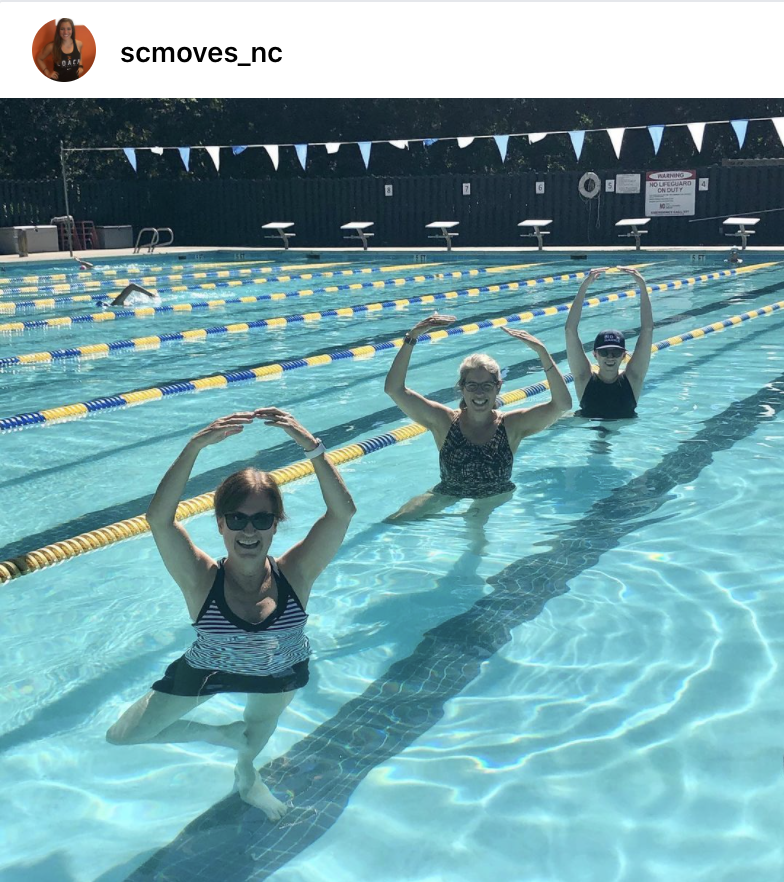
Photo credit: instagram.com/scmoves_nc
Buoyancy is another benefit that Katina points out because it allows you to do things in a floating or somewhat suspended position that you wouldn’t be able to do on land. For anyone whose skillset might be limited on land, the buoyancy can help assist the execution of some moves. Katina uses jumps as an example.
“The hydrostatic pressure and support of the water against the body also offers additional benefits for pregnant participants, those with back issues, blood pressure issues, edema and more,” she says. “In addition, the cooling effect of the water is enjoyable and also a better option for certain conditions like MS.
Katina adds that the tempo in the water is slower because of the resistance which helps people go at their own pace and not feel the pressure to say on the beat. This works really well for mixed-level classes, she says, where the experience level varies and more modifications may be required.
Can you adapt most standing barre exercises for the pool?
Sorry no back dancing or seated pretzel exercises in the pool, for obvious reasons, but there are many standing exercises you can adapt for the pool from the studio.
Katina compares barre in the water as more of a sibling than a twin to barre on land. “Probably half or fewer of barre exercises translate well into the water, with the keyword being well,” she says. Not all barre exercises that can be done in the water, should be done in the water because they wind up being not as effective as their land counterparts, thanks to gravity or lack thereof.
For Katina, it’s all about striking a balance between moves in aquatic barre that honour the foundational idealogy of barre and the properties of aquatic fitness.
“In the interest of good programming and challenging participants and not just having them go through the motions not all that can be done, should be done.” – Katina Brock
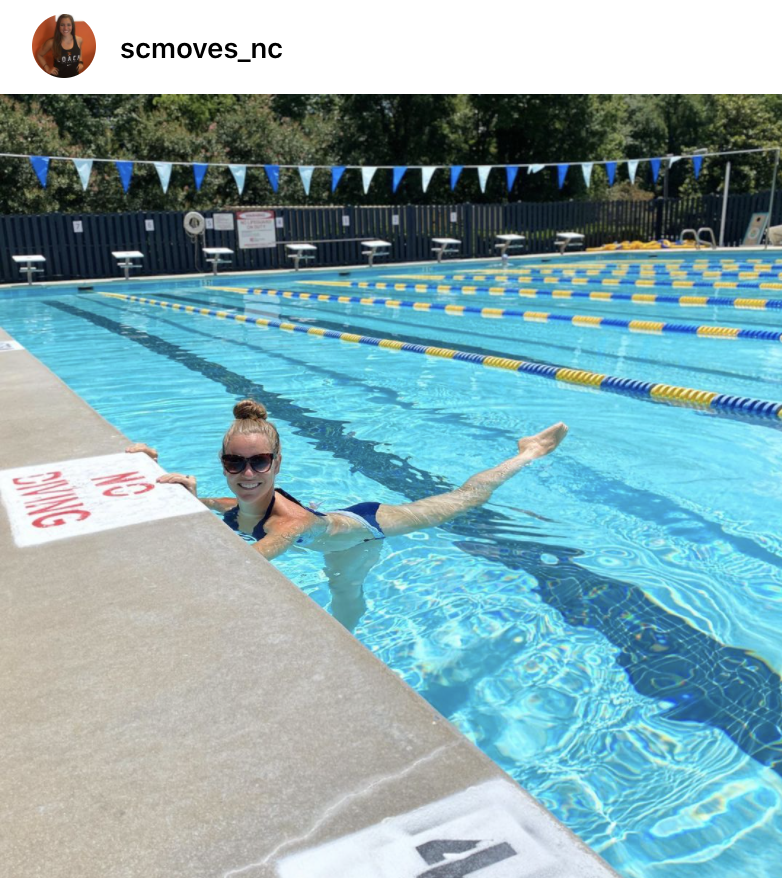
Photo credit: instagram.com/scmoves_nc
Does the water make an already low-impact workout even lower impact?
We know that barre is low impact so I wanted to know does taking a barre class in the water make the exercises even more low impact?
The answer is yes! “The water is also really helpful in eliminating tension in the hip flexors – leg lifts, grand battements, passés, and more feel better in the water because there is less gravity,” Sarah Catherine says. “Plus, the water adds additional resistance to work the muscles differently.”
“It’s also always possible to dial-up or dial back the intensity. Too easy? Jump higher! Grab a larger set of dumbbells! Too intense? Eliminate the weights, stay on flat feet, march instead of jogging, etc.” – Sarah Catherine Carter

Photo credit: Wet Barre™
Just a Few of the Barre Exercises You Can Easily Adapt for the Pool
Need some inspiration? Here are a few barre exercises that can be adapted for the pool.
Marching
You know this exercise most likely from the beginning of barre class when you’re marching on the spot. It’s a great exercise to get your heart rate up and it works well in the pool too. Now you’re competing with balance and a lot of resistance through the water as well.
Start by lifting your knees up to hip height through the water, marching on the spot. Throw in a twist if you like to work your obliques.
Pushups On the Pool Ledge
We all know you can use the barre for modified pushups, so the same goes for the pool. Just use the wall edge as your barre. 10 of these at a time work well.
Calf raises (first or second position)
Calf raises are great in a studio but also work well in the pool. Start out in the first position with your feet turned out in a narrow V position, heels together toes apart. Raise your heels off the ground, then back down 10 times or more.
Wide Second Variation
Turn your feet out into a wide second position, wider than hip-width. Plie, raise your calves, rise up tall to straight legs and repeat this motion 8-10 times.
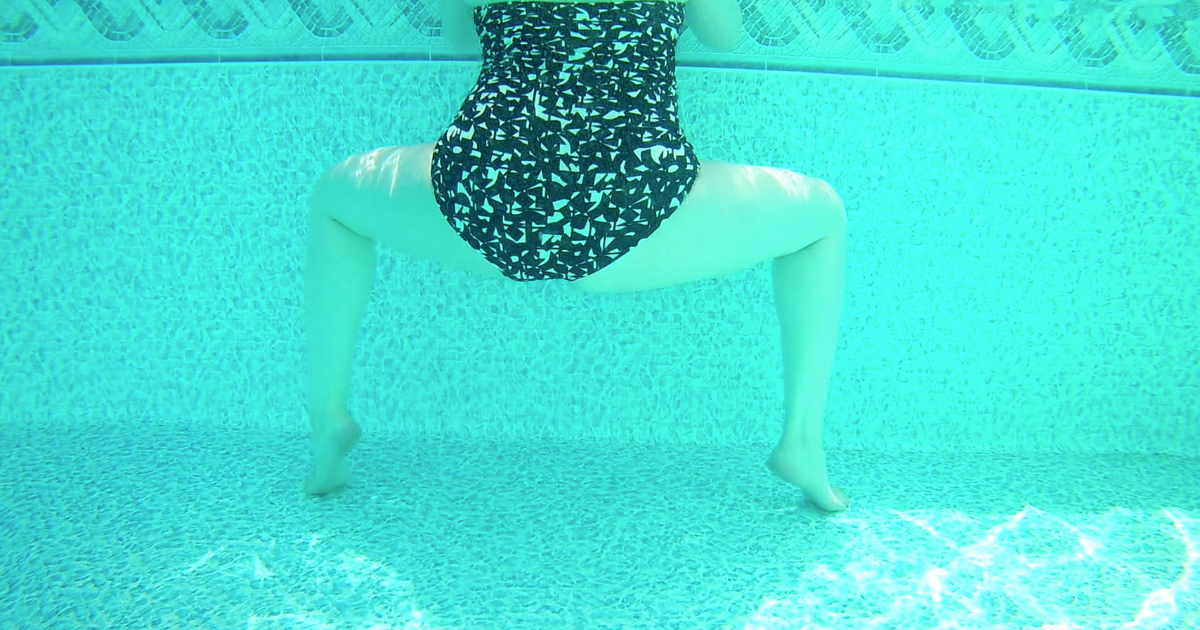
Leg Lift Series
This is a great top-of-the-thigh exercise, that has many variations.
Setup
Stand profile to the edge of the pool. Your feet should be in a parallel position and hip-distance apart. Place your inside hand on the ledge of the pool. Your outside arm can hover above the water or be held on your hip. Keep your core engaged and your shoulders over your hips. Your knees should have a tiny bend in them.
- Variation 1: Lift your outside leg as high as you can get it without leaning back, then bring it back down to the floor of the pool. Repeat 8-10 times.
- Variation 2: With your leg lifted as high as it can go, straighten then bend your leg, so you are doing a bend-stretch motion. Your foot is in a pointed position. Repeat 8-10 times.
- Variation 3: Lower your leg to the pool, lift it back to hip height or as high as you can lift it, followed by a tiny bend-stretch motion. Repeat 8-10 times.
- Variation 4: Flex your foot at hip height and just repeat a tiny lift, lift, lift motion, 8-10 times followed by a hold at the end.
Lunges
Everyone’s love to hate exercise in the barre classroom translates well to the water too. Now you’re also competing with balance, (in a different way).
Standing (Floating) Pretzel
We know that you obviously can’t do a seated pretzel exercise in the pool but there is still the standing option which is great for your seat.
Set up
You can use the ledge of the pool or hang onto a pool noodle for this exercise.
Start by facing the barre in a parallel position. Bring your heel toward your seat. Soften the standing leg. Toes are pointed. Next, rotate up and over the left shoulder, lifting up through the side body so you are now working in an open hip position, facing profile to the barre. Your hips are still square.
- Variation 1: Pulse up in one-inch movements.
- Variation 2: In a circular motion rotate the leg. Repeat 8-10 times, then change directions.
- Variation 3: Keep your leg lifted while you point and flex your foot. Repeat 8-10 times.
Repeat this entire series on the other side, to even things out.
Where can you find Katina and Sarah Catherine?
Katina is the creator of Wet Barre™ and a continuing education provider in aquatic fitness. She offers weekend trainings with a variety of workshop topics to choose from such as Wet Barre: Booty, Wet Barre: Pilates, Wet Barre: With a Twist (rotational movement), Wet Barre: Power (cardio/strength intervals), Wet Barre: Extend (legs) and much more. You can find her at wetbarreworkout.com and at @wetbarreworkout on Instagram.
Sarah Catherine Carter teaches at the Hollow Rock Racquet & Swim Club in Durham, NC and can be found at @scmoves_nc on Instagram.



